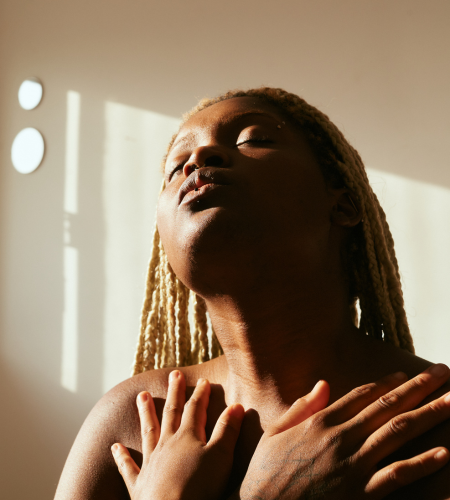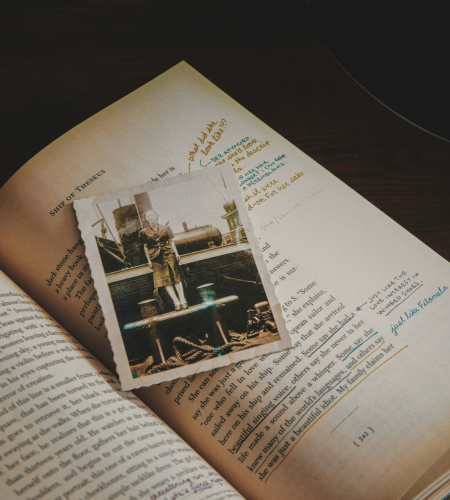
Are you familiar with the feeling of panic? You're mind races, your heart is pounding and you can't seem to get a breath of air. It's an awful experience, and for some people (hello it’s me) it happens often. If you're looking for ways to calm yourself down during a panic attack, here are 10 breathing techniques for panic attacks to try that have helped me during moments of high stress.
I remember my first panic attack. My thoughts were racing, I couldn’t breathe, and it felt like it was getting worst by the second. I didn’t realize it was happening until I couldn’t get my breathing under control. It felt like no matter how much I inhaled, no air was filling up my lungs.
Everything around me was calm, yet I was anything but. Inside I was loosing it, and I felt like I was going crazy.
Panic attacks happen to different people for different reasons, and each panic attack for each individual can happen for different reasons as well. For me, my panic attacks are usually tied to something with time, and not having enough of it to do things that I need to get done. I haven’t cracked the code yet as to why time leads to panic attacks but, sure enough, every panic attacks leads back to stress due to a perceived lack of time.
I’m working to find the root trigger so that I can heal that part of me that sets off my fight or flight when I think I’m running out of time. But until then, I knew I needed to find breathing techniques that could at least calm me down during my panic attacks.
Luckily, over time, I have found a selection of breathing techniques that work to get me back to a grounded place. From this grounded place, I’m then able to think rationally and either alter my self talk, change my perspective, or take action. But those steps can only happen when I’m in a calm, grounded state by controlling my breathing with any of the breathing techniques below.
What is a panic attack?
A panic attack is a sudden, intense episode of anxiety that can feel incredibly overwhelming. Physical symptoms can include racing heart, shortness of breath, chest pain, sweating, shaking, and feeling faint or dizzy. For many people, a panic attack can feel like they're having a heart attack or that they're going to die.
Panic attacks can happen out of the blue, but they can also be triggered by specific situations, such as flying on an airplane or being in a large crowd. Once a panic attack starts, it can be very difficult to calm down and stop it from happening. However, with treatment and self-help strategies like the breathing techniques below, it is possible to manage panic attacks and live a healthy and fulfilling life.
Panic attack symptoms
The physical symptoms of a pain attack are:
- Shaking
- Feeling disoriented
- Nausea
- Rapid irregular heartbeats
- Hyperventilating
- Dry mouth
- Breathlessness
- Sweating
- Dizziness
Panic attacks and shortness of breathe
The common complaint from people who experience panic attacks is shortness of breathe- feeling like no matter what they do, they can’t get enough air into their lungs.
When you’re having a panic attack, your body is in a state of fight or flight- your body is perceiving your situation as unsafe. When your body is in fight or flight, it attempts to take in more oxygen as it prepares to defend itself. This is why you feel a shortness of breathe- you feel like you don’t have enough oxygen because your body is requiring more oxygen as a result of being in fight or flight.
Feeling a shortness of breathe can also increase your anxiety and panic attacks because feeling like you can’t breathe freaks you out!! This makes you feel even more unsafe, setting off your fight or flight response even more. And the cycle continues.

How can breathing exercises reduce stress
The key to calming yourself down during a panic attack is to regulate your breathing. Controlling your breathing signals to your brain and your body that you are safe. When your brain and body start to understand that you’re safe, it calms your fight or flight response and your breathing will automatically start to regulate as well.
The key isn’t to breathe deeper - this can lead to hyperventilating. The key is to control and slow down your breathing to signal a feeling of safety to your brain.
You can read more about link between breathing and stress here.
Belly breathing vs chest breathing
Did you know that there is a difference between belly breathing and chest breathing?
Belly breathing (called diaphragmatic breathing if we’re being proper) involves taking deep, slow breathes from the bottom of your belly and then fills up your lungs with each inhalation. Chest breathing is the opposite. Your breaths are shallow and only fills up the top portion of the lungs with air when you inhale.
When you're feeling anxious or stressed, your first instinct may be to take shallow, chest breaths. However, belly breathing is actually a much more effective way to calm yourself down.
Belly breathing helps to slow down the heart rate and relax the mind, both of which can be helpful during a panic attack. It is also one of the best ways to get oxygen to the brain- which is exactly what the brain wants when it’s in fight or flight during a panic attack.
In addition, belly breathing forces you to inhale deeply, exhale slowly, and focus on your breath. This can help to clear your mind and focus on the present moment.
To belly breath, simply inhale deeply and fill your belly with air. Then exhale slowly, letting your belly fall back down. You should feel your stomach rise and fall with each breath.
Belly breathing is a simple but powerful tool that can help you to stay calm in any situation.
So when following the breathing techniques for panic attacks below or next time you're feeling anxious or stressed, try belly breathing instead of chest breathing. You may be surprised at how much it helps!
Breathing techniques for panic attacks

Even breathing
- Breathe in for 4 seconds
- Breathe out for 4 seconds
- Repeat 10 times
Tip: The goal with even breathing is to match the exhalation with the inhalation. So if 4 seconds doesn’t feel right for you, use how ever many breathes does feel right as long as it’s the same amount in and out.

2:1 breathing
- Breathe in for 4 seconds
- Breathe out for 8 seconds
- Repeat 10 times
Tip: Once you start using this, slowly start to increase the length of your breathing. Start with 2 breathes in, 4 breathes out, but then increase to 3 breathes in, 6 breathes out. Then increase to 6 breathes in, 12 breathes out, etc, etc.
The goal with these technique is to a ratio of 2:1 exhale to inhale (have double the amount of exhale than inhale). But keep the exhale length reasonable so you’re not gasping for air at the end. Your breath should flow in and out smoothly, long and controlled.

4x4 Box breathing
- Breath in for 4 seconds
- Hold for 4 seconds
- Breathe out for 4 seconds
- Hold for 4 seconds
- Repeat for 4 or 5 sets
Tip: It can be helpful if you use some imagery with this technique. Visualize a box, and move your eyes along the sides of the box as you’re breathing. So when you’re breathing in, move your eyes up along the side of the box. When you’re holding, move your eyes along the top of the box. When you’re breathing out, move your eyes down the other side of the box. When you’re holding again, move your eyes along the bottom of the box. And repeat. (You can use the image above as your visual!)
4-8 with Pursed Lips
- Breath in for 4 seconds
- Purse/pucker your lips so the hole the air is coming out of is small
- Exhale for 8 seconds
- Repeat

4-7-8 breathing
- Inhale through your nose for 4 seconds
- Hold for 7 seconds
- Exhale through your mouth for 8 seconds
- Repeat for 10 sets
Ocean breathing
- Inhale through your mouth
- Exhale through your mouth. Tighten the back of your throat to slightly constrict the passage of air - this will produce a Darth Vader sound (or sound like the ocean). Tip: Imagine you are fogging up a pair of glasses
- Repeat that same contraction of the throat to your inhales to create the same hissing/ocean/Darth Vader sound
- Repeat a couple times to get the comfortable controlling the throat with these type of inhale and exhales
- Once you get the hang of it, repeat the same contracted breathing through the nose with the mouth closed
- Repeat for 5 or 6 sets
Alternate nostril breathing
- Press your right thumb against your right nostril to close it
- Inhale through your left nostril
- close the left nostril with your fingers and let go of the right nostril
- Exhale through your right nostril
- Inhale through your right nostril
- Close the right nostril and let go of the left nostril
- Exhale through the left nostril
- Repeat steps 1-7 for 8 sets
Focus word breathing
- Pick a word that has a positive meaning to you (grace, hope, love, peace, etc)
- Say that word (mentally or out loud) as you inhale
- Say the word releasing as you exhale
- Repeat 10 times
Tip: You can pick any word that means something positive to you, and you can always replace “releasing” which any word that you want as well. The idea with the exhale is to release whatever isn’t serving you. So you can replace it with words like stress, negativity, or anger.
If you’re looking for positive mantras to use for this technique, download our free mantra list.
Roll breathing
- Lay on your back and place your left hand on your belly and your right hand on your chest
- Inhale through your nose aiming to fill your lower belly (not your chest). Notice your hand on your belly rising.
- Continue inhaling to fill up your chest. Notice your hand on your chest rising.
- Exhale slowly through your mouth, making a whooshing sound.
- Repeat 3 to 5 times
Morning breathing
- Stand up and bend forward at your waist. Keep your knees slightly bend.
- Let your arms dangle
- Breathe in slowly and deeply while you slowly roll back up to standing
- Hold your breath for a few seconds
- Slowly breathe out while bending back down
- Repeat 5 to 7 times
What is the best breathing technique for panic attacks
The best breathing technique for panic attacks is…

Anything that works for you!
Even with the suggested second amounts above, do what’s best for you. If you feel like you’re straining or gasping for breathe at any point, stop and do an amount that’s comfortable for you. If you feel like a certain technique is making you more anxious, stop and try something else. What works for one person won’t work for another, and what works for you in one situation may not work for you another time. Stick to what feels good in the moment.
Also, don’t let the counting stress you out. The focus isn’t the counting. The counting is there so you can become aware of your breathe and to guide you as to when you’re taking an inhale and an exhale. The focus is to use the breathe to calm your nervous system down. Focus on the exhale, that’s where the relaxation comes from.
Practice when you’re calm and relaxed! This will help you build up your breathing, and also help recall in stressful moments. When we are in the middle of a panic attack or our anxiety is really high, it can be really hard to recall something you’ve used once. But if you practice these breathing techniques for panic attacks when you’re calm, you’ll have a better chance at recalling them in a moment of stress.
Panic attacks are not life threatening- although they feel like in the moment. Low levels of anxiety and stress, as well as occasional panic attacks, are common and normal. It’s a part of being human. However, it can be detrimental to your wellbeing when it turns into chronic anxiety and stress.
If you’re getting panic attacks often, it might be helpful to start a meditation practice to create a sense of peace and calm within yourself. This could help you build up a resilience to stressful moments, quiet your anxiety, and boost those positive vibes we’re all striving for.
If you can’t seem to shake the panic attacks no matter how hard you try (I’ve been there), I would encourage you to reach out to your doctor or consider starting therapy. There could be a larger underlying issue that is causing frequent panic attacks that you might want to explore.
If starting therapy is the route you decide to take, I put together a Starting Therapy Guide to alleviate overwhelm and fear about starting and empower you to get help. Download it below.








+ view comments . . .
+
view comments . . .
-